What we do
Services
Experts in
Recently, there was a thought-provoking discussion on LinkedIn initiated by an HR specialist at a product company. The company hired a software developer who worked for two weeks, but their progress was too slow. Thus, the company decided to replace the developer and charge the recruiter for making a poor hiring decision. The HR specialist created a poll asking the audience the amount they should charge. Should it be the developer’s monthly salary, or 50% of it?
HR was outraged: a recruiter hired the wrong person, and now the company had to deal with the consequences!
However, creating a LinkedIn poll and making the recruiter responsible won’t solve the problem.
The company didn’t have a well-established developer onboarding process for software developers. There was no mentor to guide the newcomer through the product’s specifics; there was not enough time to set up a development environment and get acquainted with the scope of work. At the same time, there were complaints, pressure, and even penalties.
How should companies deal with the new developer onboarding process? How can they avoid possible issues? And how should you set up your onboarding process when working with a remote team?
In this article, we collect up-to-date statistics on employee onboarding, share best practices used by different digital companies, and describe five key stages of an effective onboarding process.
Keep on reading to find out how you can save money on a new hire and successfully integrate a remote developer into your team.
According to Glassdoor, the average employer spends over $4,000 and 27+ days to hire a new employee. In the post-pandemic world, hiring can take even longer. For particular industries, like IT and software engineering, it's nearly impossible to hire a new colleague in less than a month.
Fortunately, software development outsourcing helps founders hire new engineers more quickly in comparison to on-site hiring.
There are two main ways to cooperate with an IT outsourcing company:
You can find out more about these services in our article about staff augmentation and managed services.
Can you skip the onboarding stage?
Of course you can.
However, it may cost you time and money, and it may impact the quality of your product.
When you create and implement an effective developer onboarding program, you get a chance to improve multiple processes within your company:
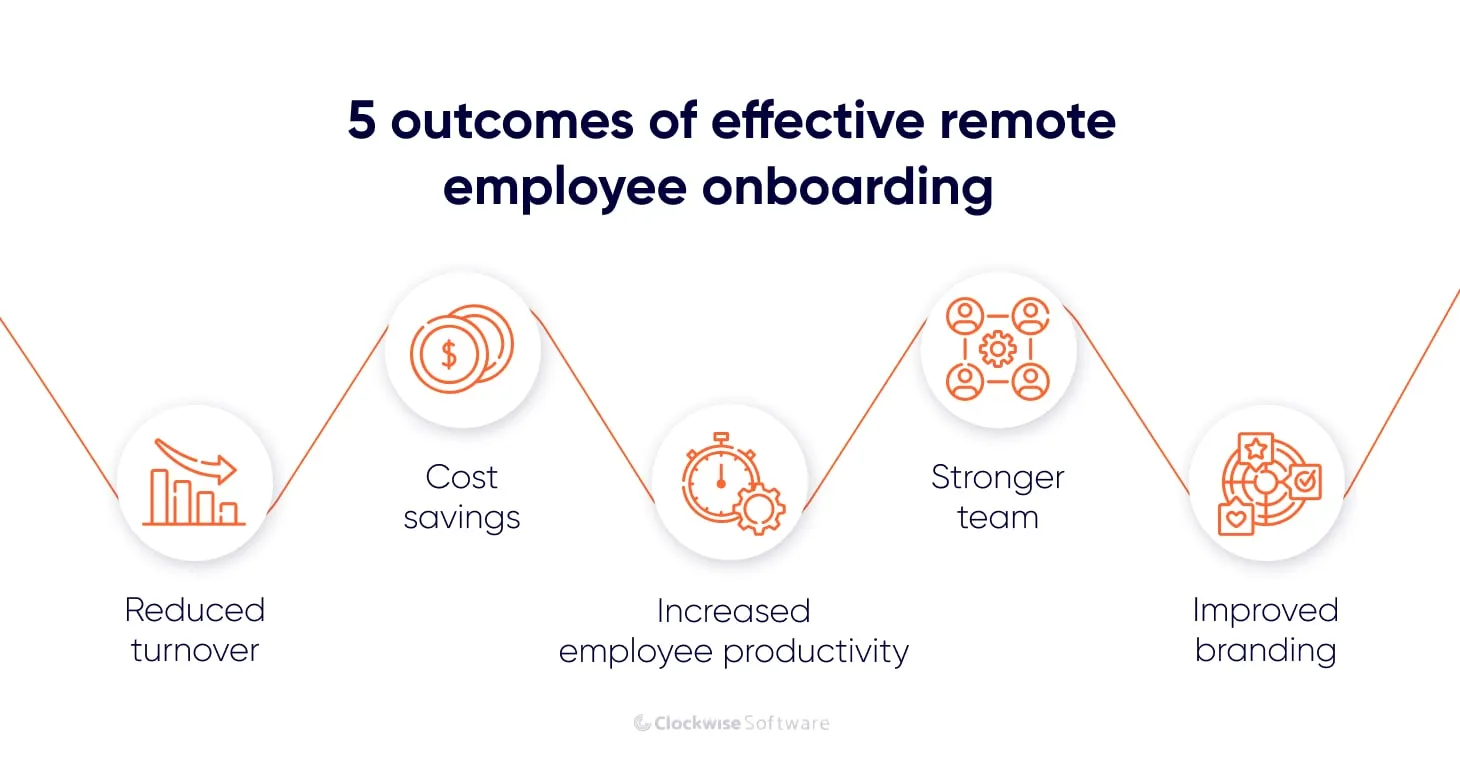
In 2017, The Webonboarding team released a report stating that 15% of employees leave their jobs because of onboarding problems.
Imagine this situation. You’ve invested weeks or months in hiring a new engineer, spent time reviewing CVs and conducting interviews, and finally closed the position. Then several weeks in, your employee just leaves. The hiring headache starts all over again.
The more often this situation occurs, the higher your turnover rate gets.
A high turnover rate impacts your reputation and diminishes your hiring efforts.
Fortunately, there’s a cure. By creating an effective developer onboarding program, you can make your new employees stay, reduce turnover, and strengthen your reputation as an employer.
Time is not the only thing you invest when hiring. You invest a great deal of money too.
Estimates of average employee turnover costs vary. According to G&A Partners, to replace a technical specialist you need to invest 100% to 150% of the employee’s annual salary.
In combination with the time you need to waste on a new hire, it may cost you a fortune to replace a software engineer.
Onboarding a new developer may help you minimize this cost. If you organize the process correctly, address new employees’ needs, and provide support to new employees during their first weeks, you can make them stay for months and years. Instead of spending money on new hires, you can invest in product improvement and promotion.
“The effects of employee onboarding last way beyond when a new person starts working and impact your whole company,” says Status Page founder Steve Klein. “If your onboarding isn’t effective, in just 1 or 2 generations of hiring, you’re dealing with a team that’s shockingly less productive than it could be — and costing you a lot of money.”
However, one of the key goals when onboarding an engineer is seamlessly integrating them into the team and increasing productivity in a stable manner. A bit of onboarding effort can multiply your employee’s productivity.
A strong onboarding program strengthens your team. According to Glassdoor, companies with effective onboarding roadmap increase retention to 82% and increase their team’s productivity by over 70% compared to a team without established onboarding.
As you hire skilled external developers and create an effective onboarding program for them, you get a chance to strengthen your entire team and work with productive and motivated software specialists.
Employees get about 90 days to prove themselves in a new job. The faster new hires feel welcome and prepared for their jobs, the faster they will be able to successfully contribute to the firm’s mission.
Mentorship and buddy programs may not only help your new teammates feel better but also improve their hard skills. We describe these programs below in the section on five stages of an effective onboarding program.
According to State of the American Workplace, only 12% of the US employees are satisfied by the onboarding process in their companies.
As you contribute to your onboarding program, you build your company’s reputation and your brand. And as you earn your employees’ trust, you can increase your company’s popularity in the market and make your company a desirable workplace for both developers in the US and remote specialists abroad.
Effective employee onboarding may turn into a tool for brand development. It has the potential to transform your entire organization and take you closer to your goals.
Bad onboarding damages the entire employee experience. According to a report by Webonboarding, 39% of respondents have faced an issue during the onboarding process or when starting a new job.
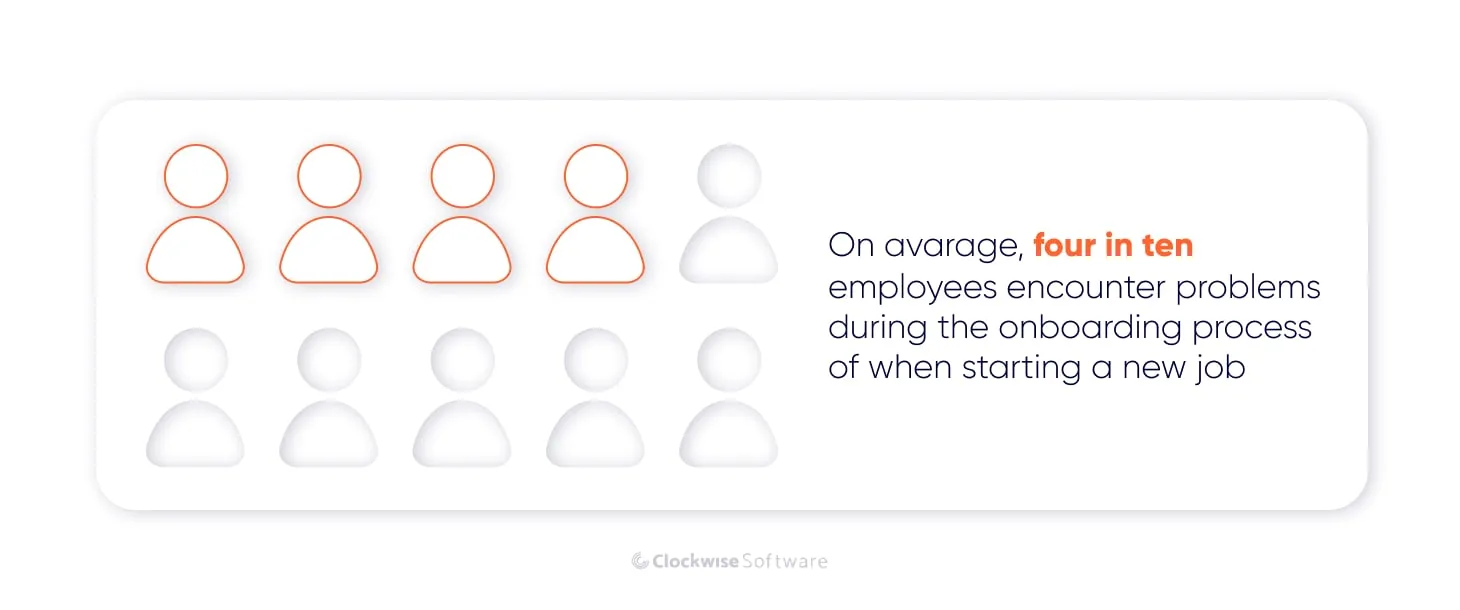
How can you create a smooth and effective developer onboarding process for your remote engineers? Use this developer onboarding checklist to integrate new teammates as fast as possible and accelerate your development process.
First and foremost, talk to your development partner.
Each outsourcing company has its own rules and policies.
To avoid misunderstandings, discuss the onboarding process with your engineering partner. State your requirements and find out how your partner organizes onboarding on their side.
Onboarding processes may vary depending on the number of specialists you hire. For example, if you hire a team of two or more developers, there should be a key developer you hire first. After completing the onboarding process, this developer will be able to help other developers with onboarding. If you hire a team of software engineers and project managers, the project managers may provide you with assistance during developer onboarding.
Make sure you talk about onboarding-related questions with your development partner even before cooperation starts.
For you, the onboarding process begins long before a person actually starts working on your project. You should have everything ready before the first day. Thus, we recommend starting to prepare the onboarding plan at least a week before the start date.
Are you responsible for providing remote developers with work devices? If yes, make sure you send equipment and a welcome pack beforehand.
Note that the delivery date will depend on the developer’s location, weather conditions, the size of the package, and multiple other factors. Contact a shipping company and find out the approximate date of delivery.
Collect personal details about your new teammate and create contracts and NDA documents. Use tools like DocuSign to automate and simplify the documents routine.
What will your new employee’s first day look like? Create a simple but clear agenda including all required activities.
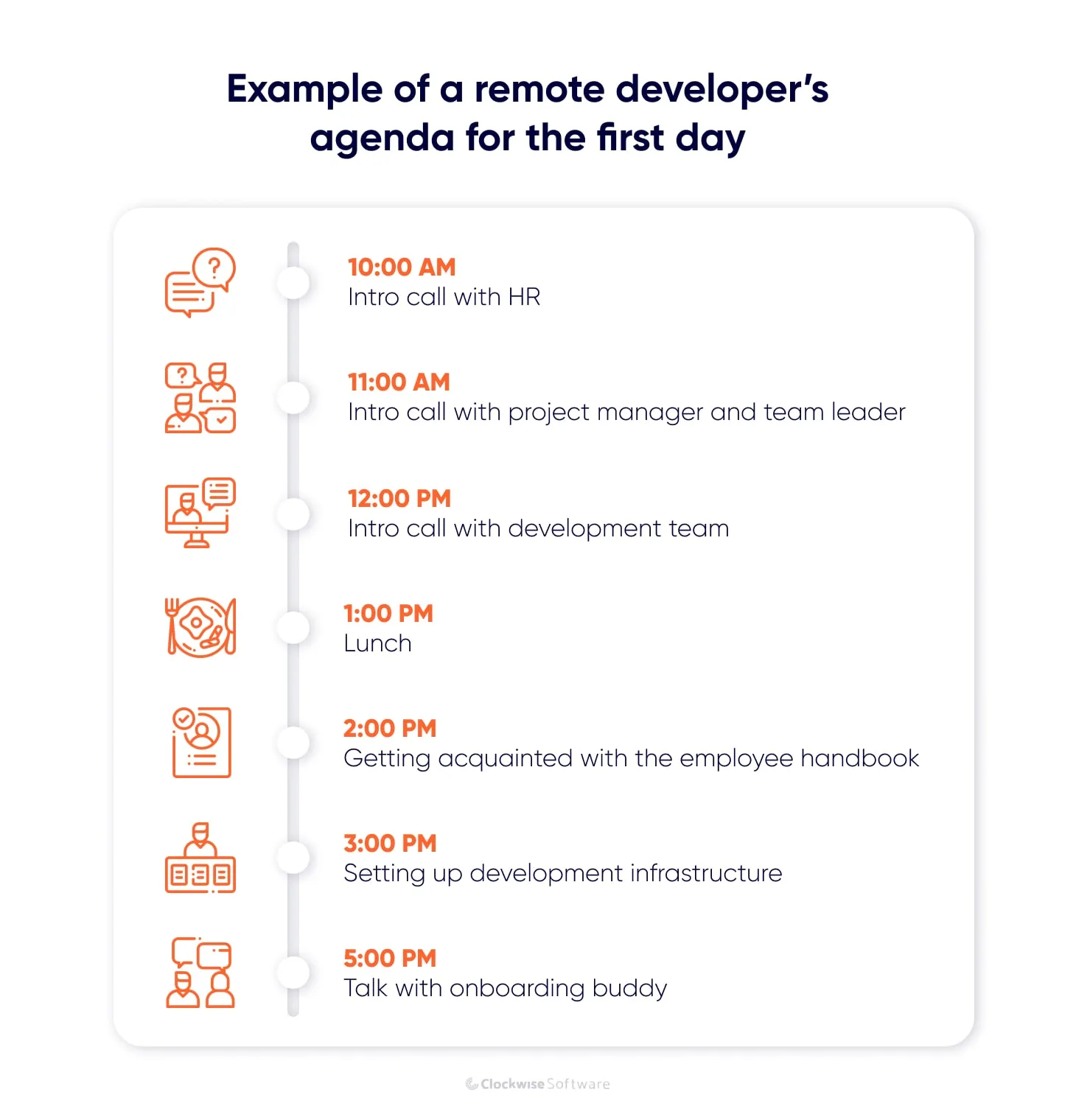
You can add details and names to the agenda to get the new teammate more familiar with people on the first day.
Have you already agreed on a start date? Send a brief informal letter welcoming your new engineer to the team. Tell them you are waiting for them to join your team, confirm when exactly the first day of work begins, and attach the agenda for the first day.
What happened at your last development team meeting? Record the most important details and create a short summary for your new teammate.
Choose a buddy for your new employee. An onboarding buddy will help them feel more comfortable in the team. A buddy plays the role of the first friend in a new environment. It’s extremely important to make sure that a buddy has well-developed soft skills and enough time to help with onboarding.
What software does your team use? The typical package includes Jira or Trello for task management, Slack or Skype for team communication, Whereby or Zoom for video conferencing, etc. Create accounts in each of these tools for your new employee.
What happens on the first day? Follow this simple plan:
Schedule a morning video conference with your new employee. Start with small talk and try to get to know your new teammate better.
The number one problem with new hires is mismatched expectations. A new employee doesn’t know what you expect. Also, onboarding is not the best time for initiatives and new ideas from someone who has just joined your team. Explain what you expect in simple words. Stick to the agenda and make sure your new teammate understands key tasks for the first day.
Provide a developer with instructions on how to set up the development environment and the project and send account details for each app.
Ask your new colleague to take a look at your employee handbook.
Note: If you don’t have an employee handbook, consider creating one and check out best practices.
Make sure your new engineer gets acquainted and builds connections with their onboarding buddy and the entire development team.
What do people expect from the first week in a new position? BambooHR has shared statistics on that:

People want to participate in training and understand company policies. They want to have time to set up work infrastructure and have a company tour. More than a half of respondents would like to be assigned a work buddy, or a mentor. Based on these insights, we’ve shortlisted tasks for the first week of onboarding:
During the first week, a new employee should slowly dive into project specifics. To help with that, create the first simple tasks for your new employee in a task management system.
Send invitations to all meetings where the developer’s participation is required.
Add elements of informal, live communication. For example, you can host virtual coffee breaks.
Do you practice training sessions in your company? Invite your new teammate to relevant training sessions to improve the onboarding experience.
If you and your internal team work from the office, you can offer a new engineer a short virtual walk around your office.
Tasks and meetings are irreplaceable components of a new engineer’s work days.
What else should you do during the first month?
Don’t leave your new teammates on their own. Keep an eye on their progress and let them know about it. Discuss ups and downs, inconveniences and successes, and develop a personal development plan acco
Talk to a new employee at least once a month during onboarding. This will help you establish reliable relations, find out if they’re facing any challenges, and react to emerging problems fast.
When the onboarding period is over, ask engineers about their feelings and opinions. Create a form asking to rate your onboarding effort and the quality of the process. This will help you with your future hires.
Typically, onboarding takes one to three months. However, the exact duration depends on multiple factors:
An employee’s experience and communication skills as well as multiple other factors can prolong or speed up onboarding.
The more attention and effort you invest in your onboarding process, the faster a new engineer will contribute to your product’s quality and functionality as well as to the entire company’s mission.
There’s no better way to set up onboarding than to study companies experienced in onboarding remote developers:
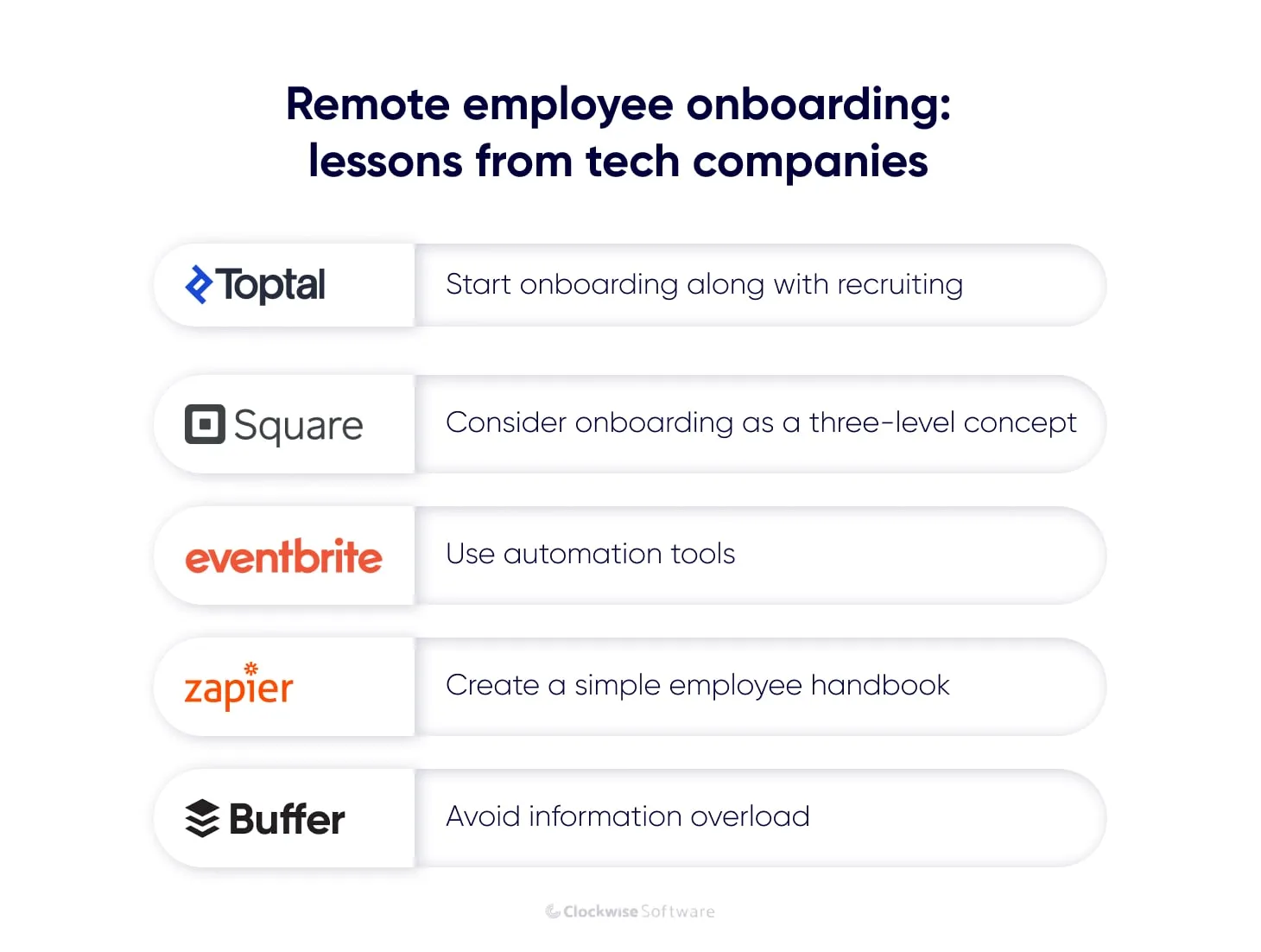
Toptal, a global remote company, introduces candidates to the onboarding process in job descriptions.
Each Toptal vacancy contains information about what applicants will deal with during their first day, first week, first month, first three months, and first six months.
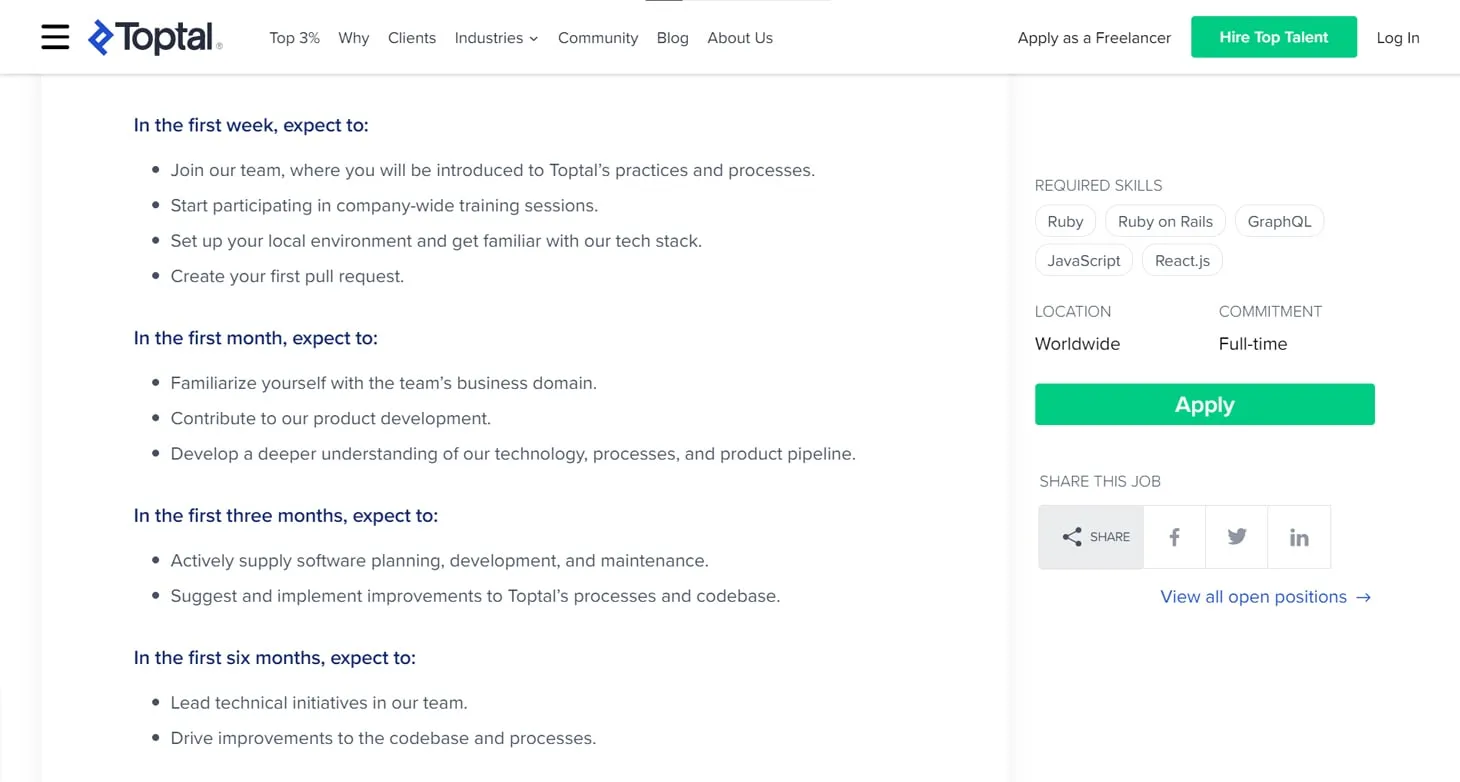
When applying for an open position at Toptal, software developers get onboarding information immediately. Isn’t it a great way to start a long-term partnership?
Discuss this point with your development partner and define key onboarding milestones in your job descriptions. It may increase candidates’ interest and create the perfect grounds for further onboarding program development.
Square, a financial services and digital payments company, has their own view on the onboarding process. Launched in 2010 in San Francisco, California, the company now has offices around the world. In May 2020, Square announced a permanent work-from-home policy.
Square divides the onboarding process into three levels:
At Square, onboarding looks like a pyramid grounded on general onboarding in the company. The first work week is mostly devoted to introductions and setting things up, while onboarding in the team starts from week two and lasts until the new colleague settles into the role.
Build your company’s onboarding pyramid. What should a new employee find out first? What documents should they sign at the very beginning? What processes require more time and are not very urgent? Look at your company’s processes from a different perspective and develop your own onboarding levels for remote developers.
Eventbrite, an event management platform with headquarters in San Francisco, California, allows its employees to choose from three work models: hub (work from the office), remote (work fully remote), and flex (work both at home and from the office).
Back in 2013, the Eventbrite onboarding process was quite straightforward. Simon Willison, an architect at Eventbrite, shared the approach on Quora:

However, as the Eventbrite team has grown, it has become more difficult to maintain the onboarding process in such a form. Adrienne Brabant, the Learning & Development Program Manager, had to cope with an increasing volume of onboarding tasks and operations. Adrienne sent emails and keynote presentations to new employees manually, with no time and tools to provide all necessary onboarding information.
The Eventbrite team decided to use Enboarder automation software to simplify the onboarding process for managers and new employees all across the company.
When opting for outsourcing mobile development, you may want to delegate as many operations as possible and avoid routine tasks. Still, you need to provide your new developers with context and onboard them. Onboarding automation tools like Enboarder or Sapling may help you with that.
Zapier is workflow automation software, and the Zapier team is distributed across over 300 locations.
Brian Cooksey, Engineering Manager at Zapier, describes the company’s entire onboarding process on the Zapier blog.
Brian draws readers’ attention to the importance of the employee handbook.
Your employee handbook doesn’t have to be a horrid looking PDF or printed binder that nobody wants to read. Make it useful and approachable.
Check your employee handbook. Have you updated it recently? Does it contain information for your remote specialists? Follow Brian’s advice and make your handbook simple and readable. Add necessary details and simplify employees’ integration.
In 2010, a small team in San Francisco created Buffer — a social media scheduling app.
In 2015, the company closed their office and started to work with a fully distributed team. Thus, Buffer was a remote-only company long before COVID-19.
Nicole Miller, Director of People at Buffer, shares multiple onboarding insights on the company’s blog. One of the things she recommends is avoiding information overload. Buffer used to overwhelm new employees with a bunch of emails and tons of information _too soon and in an unorganized manner, _as Nicole says.
Now, Buffer’s onboarding communication includes three components:
When you’re working on your onboarding checklist, remember to cut emails and documents into small portions and provide them to your new remote developers one by one. Of course, you want employees to get all necessary information as quickly as possible so they can start working on your tasks. But it’s also essential to leave some time to read, consume, process, analyze, and remember information — as well as to fill out and sign documents. So follow Buffer’s best practices and avoid information overload.
Onboarding software developers is a complicated process that may take up to three months. With a detailed guide, developer onboarding best practices, and support from a reliable software offshore software development partner, you can create an effective onboarding program and help new employees contribute to your product as fast as possible.
In our article, we recommend splitting onboarding into three major milestones:
You can implement best practices from powerful tech companies in your onboarding process to make it smooth and simple for you, your team, and your new developers.
